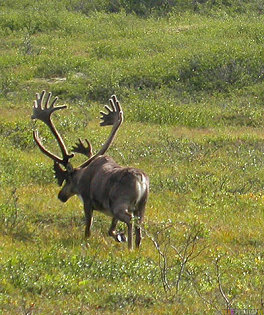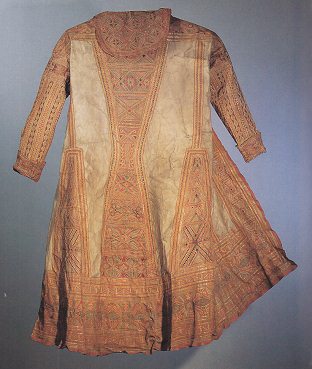from:
Prestel museum guide, text by Denise Daenzer and Tina
Wodiunig: Native Museum of Zurich (orig. German:
Indianermuseum Zürich / Indianermuseum der Stadt Zürich);
Prestel edition; Munich, New York 1996; supported by
Cassinelli Vogel foundation, Zurich, by MIGROS percent for
culture, by Volkart foundation in Winterthur; ISBN
3-7913-1635-4
<Caribou leather coat

A caribou ("American" reindeer), here in Denali
National Park in the center of Alaska [1].
Skin of caribou can be worked out as a fine
leather and then as a coat as it happened here:
|
This painted coat for men of Montagnais or Naskapi [primary
nation] is for summer times and probably comes from south
west Quebec. It's probably from about 1700 and is one of the
oldest objects of the collection.
Between 1700 and 1930 painted caribou coats were widespread
within the folks of northern and eastern parts of Quebec
Labrador peninsula. Living nomads of Naskapi, Montagnais,
Montagnais-Naskapi and eastern Cree living from fishing and
hunting were producing these coats as a honor for the
caribou. Caribou is the North American reindeer and was the
main food for the ethnicities which name themselves as
"Innu".


Caribou
leather coat
Two times a year a big hunting against caribous was
prepared. Painted caribou leather coat had a special meaning
for it. To the men appeared in their dreams a design of
force, and the coat had to be ornamented with this design so
the hunting would be successful. Mostly there were one or
two basic designs which the hunter was describing to his
wife. Then the wives transferred the design on the coat
completing them with other ornaments. Painting tools were
especially prepared bones or peaces of caribou antlers, and
for the women these tools had a very high value so the tools
were also given to the funeral to the dead body after their
death. For painting yellow natural colors were used
extracted from fish eggs, brown colors from earth, red and
blue color was bought, and green colors and black colors
were probably produced from burnt bones. Caribou coats had a
great significance, and successful hunters with several
wives even freed one of them from all housework only for
working with this leather coat production.
[The shape is a copy of a
European coat]
Producing a coat needed two big caribou leathers. Sleeves,
collar and the hood (when it was a winter coat) could also
be from a third skin and added by sewed on it. The shape of
caribou coats for this region is very special and it's
presumed that these coats had a European model introduced
from Frenchmen or Englishmen.
[Working with the fur]
Summer coats were absolutely depilated and tanned in a very
fine way. Winter coats were with the fur but the fur was
worn at the inner side, and the forepart was mostly sewed
together at the end. All caribou coats have an inlay in form
of a mountain top on their back side, and researcher presume
that this would be the center of magic force of the coat.
The inlay is symbol for the mountain range on which the God
of caribous is living.




 Caribou
leather coat
Caribou
leather coat